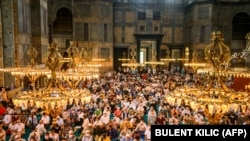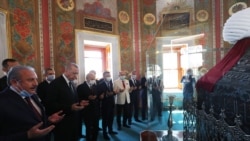On July 24, the Turkish Foreign Ministry criticized a United Nations Educational, Scientific and Cultural Organization (UNESCO) report that objected to Turkey’s conversion of the historic Hagia Sophia and Chora museums to active religious sites.
The two landmarks are among nine in the Historic Areas of Istanbul World Heritage Site. Turkish President Recep Tayyip Erdogan, an Islamist, began holding Islamic prayers at the Hagia Sophia last year. The centuries-old building has served as both a mosque and Christian church, as has the Chora museum.
Turkey’s Foreign Ministry dismissed UNESCO concerns over changing the status of the two buildings:
“The ongoing restoration programmes and other implementations in both monuments have no negative impact as per to UNESCO standards.”
But that is misleading. The renovations and scheduling of religious services may well affect their status on the World Heritage list.
Turkey did not share its renovation plans with the U.N.’s World Heritage Committee before announcing its plans to convert the two museums. Those plans include the rehabilitation of a madrasa, an Islamic religious school in the north side of Hagia Sophia, and covering the floor with a prayer carpet.
According to Bianet, an independent Turkey-based human rights communications network, UNESCO can remove an endangered site from its list if the site’s universal significance is undermined.
For the moment, however, the main concern is that Turkish authorities “ensure proper conservation and public access to the site,” Jonathan Bell, vice president of programs for the World Monuments Fund, told National Geographic.
The controversy started on July 10, 2020, the day Erdogan issued a decree to switch the Hagia Sophia back to a mosque. That move came after a high court annulled a 1934 law declaring the iconic building a museum because of its shared religious heritage.
After issuing his decree, Erdogan joined hundreds of worshippers in the first formal Muslim prayers held inside the building in decades.
Erdogan has also reconverted the historic Chora museum, a Byzantine cathedral that dates to the sixth century, to a mosque in August 2020. The Chora became a mosque in 1511 under the Ottoman Empire. In 1945, the secular Turkish Republic opened it to the public as museum.
UNESCO said in its report that Turkey had delayed plans to turn Chora into a mosque as the site will undergo a two-year, large-scale conservation project and will not be open to visitors. This came after UNESCO warned Turkey that unilateral changes will affect the Chora's World Heritage standing.
Mosaic panels with Christian symbols on the Hagia Sophia’s ground level will be covered during Muslim prayers by motorized panels, meaning visitors who want to see the mosaic panels will have to come at other times. A similar system will be used to cover the Chora’s frescos.
Turkey says the two monuments will be open to all visitors, but that tourists will have to abide by restricted visiting hours and a dress code. Regulations for visiting mosques in Istanbul require that women cover their heads, and their bodies must be covered with wide wraps. Men need to cover their knees and refrain from wearing tank tops.
Visiting rules to the two sites will follow similar regulations applied when visiting Islamic monuments in Turkey, such as the Suleymaniye mosque, one of Istanbul’s biggest tourist attractions. Guidance on the mosque’s website specifies visiting times and suggests not bothering worshippers by taking photographs.
Hagia Sophia is the most popular tourist attraction in Turkey: more than 3.7 million tourists visited the museum in 2019. Turkey claims the conversion of the museum back to a mosque did not affect the number of people who visited, given that 3 million people did so in 2020.
In a Foreign Ministry statement about the controversy published by Bianet, Turkey maintained that making changes to the two revered monuments was its sovereign right.
"The Grand Mosque of Hagia Sophia and the Chora Mosque, the components of the World Heritage Site 'Historic Areas of Istanbul', are restituted to mosque upon the decisions of the Turkish Council of State following a legal process," the statement said.
"The Hagia Sophia and the Chora are the properties of the Republic of Turkey that are meticulously conserved in terms of historical, cultural and spiritual value."







